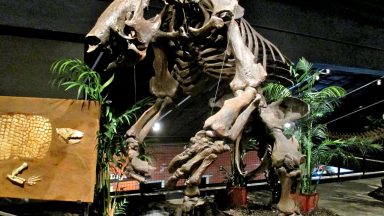
Ice Age hunters in South America preferred now-extinct megafauna
Recent research indicates that the extinction of Pleistocene megafauna may have been significantly influenced by human activity. A group of archaeologists has investigated animal bones found at locations that date back to the final years of the last Ice Age, revealing that ancient hunters in South America likely consumed large extinct creatures such as giant sloths, giant armadillos, and elephant-like species. The study, led by archaeologist Luciano Prates from Mexico's National University of La Plata, involved a detailed examination of animal remains at 20 archaeological sites across present-day Argentina, Chile, and Uruguay. The researchers meticulously compared the bones of extinct megafauna—defined as animals weighing over 44 kilograms—with those of smaller prey, alongside the remains of extant species like vicuñas. The objective was to determine whether these colossal creatures formed a significant part of the diet for Ice Age populations. The sites targeted by the team date back over 11,600 years, prior to the disappearance of the continent’s last Ice Age megafauna. The researchers focused on bones that exhibited clear signs of butchering, such as cut marks and percussion damage. Findings revealed that at 15 out of the 20 sites analyzed, the majority of butchered bones belonged to extinct megafauna. In fact, at 13 of those sites, these ancient creatures constituted over 80 percent of the total animal remains. This suggests a distinct preference among early hunters for these now-extinct species, including giant sloths, giant armadillos, extinct horse species, and even relatives of modern elephants when available. In central Chile, researchers identified Notiomastodon platensis, a now-extinct relative of modern elephants, as a primary target, with its size comparable to that of a modern Asian elephant but lacking tusks. Meanwhile, in regions such as Patagonia and the Pampas grasslands, hunters seemed to predominantly favor two species of giant sloths, indicating a varied yet specific predilection for megafauna across different environments in ancient South America.
Decoding the Climate Tech Hype: What's Worth Your Attention?
In the ever-evolving realm of climate technology, distinguishing impactful innovations from mere hype can be challenging...
Mint | Oct 17, 2025, 04:34
From Headphones to Loyalty: How One Entrepreneur Revolutionized Customer Retention
Andrew Lissimore, the mind behind the audio gear website Headphones.com, has dedicated nearly a decade to catering to au...
TechCrunch | Oct 17, 2025, 04:34
Kuku Secures $85 Million to Boost Content Creation in India's Mobile Landscape
Kuku, an Indian storytelling platform supported by Google, has successfully raised $85 million in a recent funding round...
TechCrunch | Oct 17, 2025, 04:45
Reddit Rolls Out AI-Enhanced Search in Five New Languages
In a significant move, Reddit has announced the expansion of its AI-driven search functionality to include five addition...
TechCrunch | Oct 17, 2025, 04:40
Chemtrail Conspiracy Theories Targeted for Federal Focus by Health Activists
In a surprising development, the Make America Healthy Again (MAHA) movement is urging that chemtrail conspiracy theories...
Ars Technica | Oct 17, 2025, 04:32